A Trip to Paradise – Galapagos Islands
We visited three of the Galapagos Islands from July 1 to July 10, 2015, flying from Guayaquil and traveling by boat between the islands. We spent three nights in each of the islands of Santa Cruz, Isabela, and San Cristobal. During our days there, the wildlife above and underwater captivated and fulfilled us! There is no doubt that the observation of the species living in these islands motivated Charles Darwin’s Theory of Evolution. The beauty and vulnerability of these islands should motivate humanity to work harder on the goal of reducing our footprint on earth to conserve life as it is.
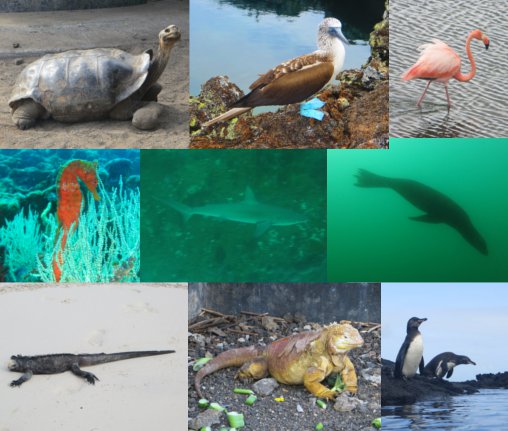
Visiting these islands was a dream-come-true for us. The Galapagos Islands is an expensive destination, but their uniqueness made every penny we spent worth it. In order to reduce the cost as much as possible we made the following decisions:
We booked our flights in and out of the islands three months in advance.
We decided not to take a private cruise around the islands but to stay in islands where accommodation was available and to travel by boat between them.
We researched and booked our hostel accommodation in each island one month in advance to guarantee low prices as well as places where we could have kitchen access.
We bought groceries and cooked the majority of our meals.
Our strategy to save money was mainly to cut down on certain expenses that seem less essential to us without missing out on special activities like scuba diving and snorkeling, which truly made our experience unforgettable.
The islands that we visited are 3 of the only 4 populated islands in Galapagos. We were told that only 3% of the entire national park was inhabited by humans. We explored beautiful places and learned a lot of things in each of the islands we visited. In Santa Cruz Island, we were surprised by the tall opuntia cactus, plants that are fundamental for the survival of the giant tortoise and iguanas who feed on them. During our first day in the Galapagos we observed giant male tortoises in captivity appearing to have sex in the Charles Darwin Research Center, proof that in nature sexuality is not only for reproduction but also for pleasure.
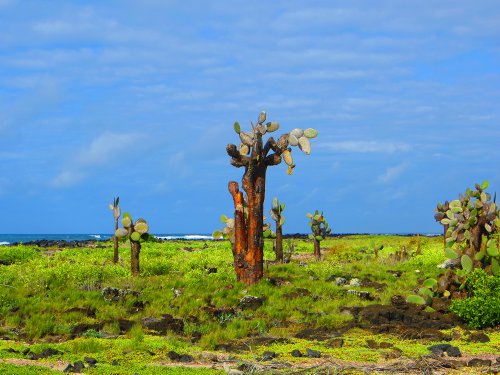
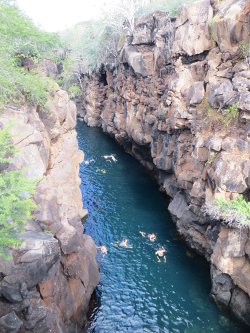
During our three days in Santa Cruz, we visited Tortuga Bay, Las Grietas, The Lava Tunnels, and Los Gemelos. In Tortuga Bay, we loved seeing the marine iguanas, pelicans, and birds in their natural habitat. Las Grietas, with a mix of rain and ocean water, was a perfect canyon of pools to refresh ourselves. We have never walked through a tunnel of lava as long as the Lava Tunnel, it was like going into the earth to understand how these precious volcanic gems were created. From Santa Cruz Island, we joined a scuba diving excursion to Beagle Rock and Daphne. We were amazed swimming close to so many green turtles, sea lions, fishes, various sharks including the hammerhead, white tip reef, and Galapagos. Scuba diving in Galapagos has been without a doubt the most exciting immersion of our lives so far!
Marine Turtle
Our second stop was Isabela Island, the biggest of Galapagos Islands and distinguished by its unique sea horse shape. Isabela is home to 5 volcanoes and a variety of life. From 1946 to 1959 this island was not what we know today, it was home to the infamous Isabela Penitentiary Colony. During our first day in the island, we walked 5 km from the port to the Wall of Tears, a useless wall built by the prisoners who were victims of abuse.
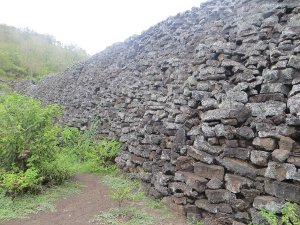

Along the walk we ran into beautiful animals that displayed acts of freedom, including the black marine iguanas camouflaged on the rocks and napping on the white sand beaches, the pelicans diving for fish into the ocean, the blue footed boobies birds resting in big groups, and giant tortoises walking slowly on footpaths. In Isabela Island, we joined a hiking tour to the Volcano Sierra Negra and Volcano Chico and learned that the Galapagos Islands have been formed by the same type of lava that created Hawaii. We felt as if we were in another planet while we looked at all the colors and shapes formed by the dried lava. While in Isabela Island we also got to see beautiful flamingos living in lagoons with a balanced level of sea and fresh waters. We discovered that there are only 12 species of giant tortoise in the world and Isabela Island is home to 5 of them.
Tortoises mate during the hotter months and the female makes a hole in a dry area and lay between 6 to 14 eggs. The baby tortoises are born about 160 days later. Once the baby tortoises are out, they have to survive on their own. Currently, almost all the baby tortoises that are born in the wild die because some of the animals (cows, pigs, goats, donkeys, dogs, cats, and rats) introduced in Galapagos by the first residents kill them directly, by eating or stepping on them, or destroy the environment they need to survive. This is why the centers that raise and protect them are so important. In the centers, adult tortoise are kept in captivity to reproduce and the baby tortoise are kept under protection for about 8 years until their shells are hard enough to resist the attacks of predators in the wild. Giant tortoises have a long life expectancy compared to humans and it takes them about 150 years to look really big. 🙂
Giant Male Tortoises in Santa Cruz Island
During our third day in Isabel Island, we went snorkeling on a tour to the Tunnels, which are lava formations in the south of the island that are now covered in ocean water. We took a boat to this destination and on our way there we were lucky to encounter a group of manta rays in which our guides gave us the opportunity to snorkel around them. The mantas were huge and playful which was at the same time exciting and scary to be so close to them. When we reached the Tunnels we were impressed by the bridges and channels formed by the dried lava with cactus plants on the top of the formations and so much marine life underneath. Snorkeling at two different sites around this volcanic coast allowed us to see penguins, blue footed boobies, pacific sea horses, white tip sharks, green turtles, and many fishes.
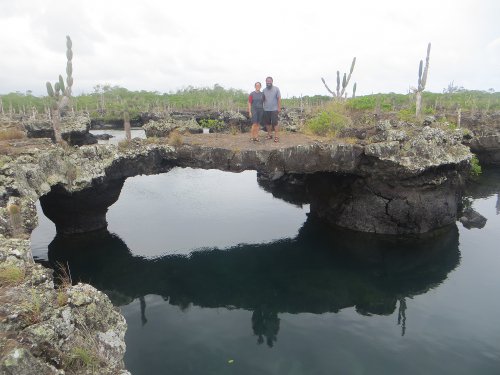
Back at Villamil town, where we were staying in Isabela Island, we ended our day by enjoying a delicious dinner of grilled sea food. It was the perfect ending to our days in Isabela Island. Traveling by boat from island to island under good weather and sea conditions does not take long, a minimum of two hours between Isabel and Santa Cruz, and almost the same from Santa Cruz to San Cristobal. However, the strong marine currents that meet in the Galapagos Islands and bring so much life to them can make these short boat trips a much longer and bumpy experience. After taking two boat trips on the same day to travel from Isabel to San Cristobal we were exhausted, luckily we took motion sickness pills before and did not get sick along the way. Unfortunately, many other passengers did not have the same luck, but after almost 5 hours of rough boat rides we felt the sensation of being on a boat until the following day.

Our last dive was from San Cristobal Island near the famous Leon Dormido or Kicker Rock. We scuba-dived at two different sites and we got closer than ever to sharks. We were surrounded for several minutes by many Galapagos sharks and some white tipped reef sharks. On our second dive, we saw a huge cloud of hammerhead sharks passing by. We also saw green turtles and a big variety of fish. How could scuba diving get any better after being in Galapagos? We fear diving will not be as exciting after these amazing encounters with marine wildlife. After our diving, we visited Cerro Brujo Bay and learned about the sea lions’ life cycle, group organization, and reproduction. We saw baby, females, bachelors, and the alpha male sea lions hanging out in a beautiful white sand beach with a turquoise ocean!
Reef Sharks
Sea Lions Playing
During our days in the Galapagos Islands, we learned not only about the origin of these volcanic treasures, its fauna, and flora, but also about the history of the people who came to them. From pirates, colonizers, Ecuadorian prisoners, US army, and current settlers, these important islands that inspired Darwin’s, have been exploited and victim of the abuse and poor choices by many humans. The giant tortoises have been at risk of extinction due to human hunting and even though this practice has stopped, the tortoise now can no longer reproduce freely because many of the animals that have been introduced by humans have become its predator. The natural balance of the islands continues to be at risk. The National Park says that only 3% of the islands are dedicated for human occupation, but we wonder if it is not more. We were, for example, surprised to see huge extensions of land destined for farming and cow grazing in Santa Cruz Island. The islands do not have sources of fresh water and yet the population living in Santa Cruz, Isabel, San Cristobal, and Floreana Islands are expected to keep increasing. Tourists like us keep coming and more food, water, electricity, and gasoline needs to be consumed. In Isabela Island, we were shocked and upset to see a hotel with a swimming pool adjacent to the ocean.
Why is this type of construction allowed in a National Park without water resources? What type of tourism is the National Park promoting? Where are the consciousness of the responsible authorities, business owners, community members, and visitors that permit or condone these types of hotels to be built? While we were walking to Loberia Beach in San Cristobal Island we saw several construction machines digging and getting soil from an already deep hole. It looked like a cemetery of what used to be a beautiful hill. We were told by a resident that the hill was completely destroyed to get soil for construction projects within the island.

We were in shock, felt angry, and very disappointed to see this exploitation of natural resources. Are not the Galapagos Islands a National Park and a UNESCO World Heritage Site? Why are these types of practices allowed in Galapagos? Or is “Galapagos National Park” just a name used for convenience by the Ecuadorian government to be able to charge $100 USD to every foreigner visitor? The concerns continue as we were told by residents of the islands that the Ecuadorian government has made changes in the legislation of the marine protected areas and they themselves do not understand what will be the possible implications of this new law. We must say that we left Galapagos with two feelings: 1) Happy to have seen for the first time in our lives a variety of fauna and flora that cannot be seen anywhere else in the world. 2) Worried that all this biodiversity could be gone one day and future generations may not have the privilege to experience it.
But when July 10, 2015 arrived, we left the Galapagos Islands not wanting to leave… This portion of the trip has been without a doubt a highlight along our world journey. 🙂
